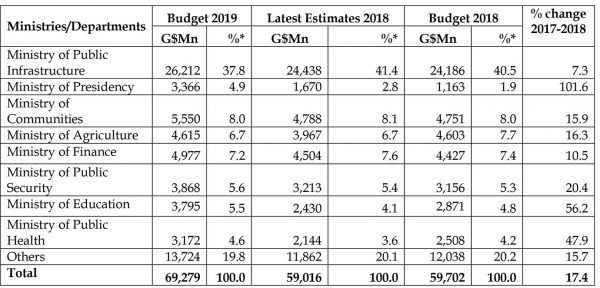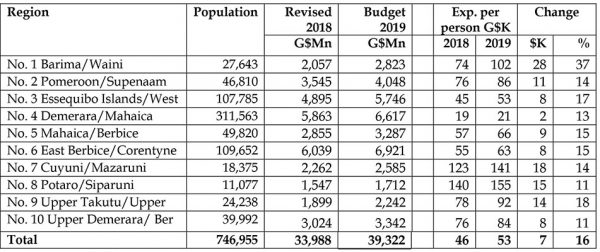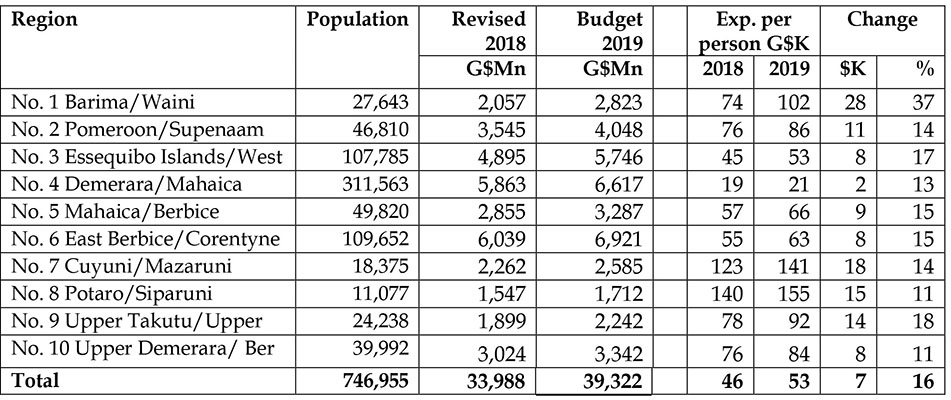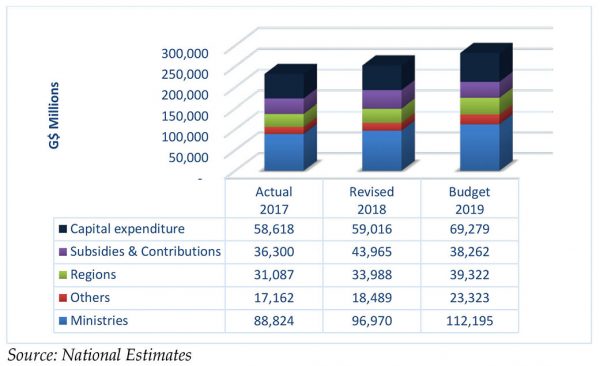Analysis of expenditure
Properly executed, the Policies and Targets are reflected in the allocation of available funds via the various Ministries and other Budget Agencies. Most times execution is done directly, but at other times, via subventions and contributions to other entities. Expenditure in the National Budget is incurred under a number of categories. These are: statutory payments which are direct charges on the Consolidated Fund, including allocations for constitutional bodies and offices and public debt payments of interest and principal; Ministries; Departments and Regions; and Statutory bodies.
Expenditure is further divided between Current Revenue and Current Expenditure, Interest, Capital Revenue and Grants, Capital Expenditure and Debt Repayment. In this section, we look at the allocations to the principal Budget Agencies largely by examining the details contained in Volume 1 of the National Estimates.
In this section, Focus looks at the current and capital expenditure by the type of agency. The chart above shows the allocations with “Others”, representing Commissions, the judiciary and the Defence Force.
Central Government’s non-interest current expenditure (employment costs, statutory expenditure and other charges) for the year is budgeted at $213.1 billion which is 10% more than the revised 2018. The Ministries/ Departments with the most significant allocations and the largest changes between 2018 and 2019 are:
* Percentage of total current non-interest expenditure
Source: Budget Estimates, Volume 1, Table 6.
Ram & McRae’s Comments
While the Ministry of Finance consistently ranks at or near the top, the expenditure is not all incurred within the Ministry. For 2019, it includes payments for GRA of $6.8 billion (2018: $6 billion); other subsidies and contributions of $1.5 billion (2018: $1.4 billion); “other employment costs” which includes provisions for public service salary increases of $11.6 billion (2018: $6.2 billion) and pension increases of $3.8 billion (2018: $3.3 billion). The significant provisions for salary increases was the primary driving factor for the 30.2% increase in the ministry’s budget and represent approximately 19% of the current budgeted employment cost.
The Ministry of Public Security, comprising the Police Force, Prison Service, Police Complaints Authority, Fire Service and Customs Anti-Narcotics Unit, is allocated $11.5 billion for employment cost, representing 65% of the Ministry’s 2019 Current Budget. As with the Ministry of Finance, salary increases remain the driving factor for the increase in the ministry’s budget and to a lesser extent overhead expenses and other operating expenses.
The allocation for the Ministry of Agriculture of $9.7 billion represents a decline of $8.1 billion compared to the revised 2018 allocation, attributable to the non-recurrence of severance payments for GuySuCo which was affected by appropriations in 2018. The major subvention for 2019 is to be made to the National Drainage & Irrigation Authority amounting to $5.5 billion, an increase of $1.9 billion or 58%, reflecting the additional work taken over from GuySuCo which had previously handled drainage and irrigation in the communities surrounding the closed estates.
Current expenditure allocation for the Guyana Defence Force is $12.9 billion, up from $11.5 billion in 2018. Between 2014 and 2019 total expenditure on the Army would have risen from $7.4 billion to $12.9 billion, placing the Army at #6 of the 40 Budget Agencies, higher than the allocation for the Ministry of Agriculture and for each of the ten Administrative Regions.
Proposed expenditure of $9.1 billion for the Ministry of the Presidency – a super-ministry with a massive ten Programmes including Defence, Citizenship, Social Cohesion, Energy, Environment, Culture, Youth and Sport – represents a 17% increase over actual 2018. For the newly created Department of Energy within the Ministry, the budget allocation is $424 million.
By comparison, the Office of the Prime Minister which according to the APNU+AFC Manifesto should have seen a rebalancing of the powers and responsibilities of the President and the Prime Minister has a single programme, described as the Prime Minister’s Secretariat.
Capital Expenditure
Central Government’s capital expenditure for the year is budgeted at $69.2 billion which is 17% above the revised 2018 and 24% of total 2019 expenditure. The Ministries/ Departments with the most significant capital expenditure allocations are:
 * Percentage of total capital expenditure
* Percentage of total capital expenditure
Source: Budget Estimates, Volume 1, Table 8.
Ram & McRae’s Comments
Further details on the budgeted capital expenditure of the Ministry of Public Infrastructure, Finance, Agriculture and Presidency are included in section The Government of Guyana Financial Plan 2019 of the Focus on the Budget.
The Ministry of Public Infrastructure continues to finance the CJIA Modernisation project with $1.1 billion budgeted for 2019, evidence that the project is finally coming to conclusion. Additionally, the Ministry provided $120 million for the maintenance of the Berbice River Bridge pontoons, since the Government took over the Berbice Bridge Company in early November 2018. The legality of the takeover remains questionable and there will no doubt be a legal battle over compensation if the Government chooses to retain control over the Bridge.
Under the Ministry of Presidency, there is a curious provision of $95 million as Capital Expenditure for “developmental, humanitarian and other activities”, a term so amorphous that the funds can be used for practically any purpose far removed from Capital Expenditure. There is too the continuing capital expenditure programme for which an allocation of $57.8 million is made provided for works on the office and residence of the President. Pre-2015 we criticised expenditures on the office and residence of the President under the previous administration; however, post 2015 capital expenditure renders the pre-2015 expenditure miniscule in comparison to funds expended post 2015. Total expenditure since 2016 has shown an upward trend as reflected in the table below.
 Noteworthy capital provisions under the Ministry of Education for the nursery to tertiary levels includes $250 million, up $100 million or 67% compared to the 2018 budgeted amount for integrated curriculum reform in the nursery to secondary level and provisions for the strengthening of the Faculty of Health Sciences and Construction of the Health Sciences building at the University of Guyana, Turkeyen Campus. Provisions of $448 million are also made for infrastructural upgrades and rehabilitation of Campus buildings, which is up $298 million or 199% compared to the $150 million revised 2018 budgeted amount.
Noteworthy capital provisions under the Ministry of Education for the nursery to tertiary levels includes $250 million, up $100 million or 67% compared to the 2018 budgeted amount for integrated curriculum reform in the nursery to secondary level and provisions for the strengthening of the Faculty of Health Sciences and Construction of the Health Sciences building at the University of Guyana, Turkeyen Campus. Provisions of $448 million are also made for infrastructural upgrades and rehabilitation of Campus buildings, which is up $298 million or 199% compared to the $150 million revised 2018 budgeted amount.
Included under the Ministry of Public Health are provisions of $439 million for the construction of the Ministry’s Head Office Complex and a laboratory for the Food and Drugs Department. This provision is up $275 million or 168% compared to the revised 2018 budget. Rehabilitation of various hospitals is budgeted at $380 million, up $244 million or 179% compared to the revised 2018 budget. $650 million has been budgeted for enhanced health care delivery and improved health facilities, up $610 million from the revised 2018 budgeted amount of $40 million.
An analysis of expenditure per person using the 2012 Census as the basis is as follows:
 Source: Budget Estimates, Volume 1, Table 6 and Census, Bureau of Statistics.
Source: Budget Estimates, Volume 1, Table 6 and Census, Bureau of Statistics.
Although Region No. 4 appears to receive the lowest direct allocation per person, agencies such as the Georgetown Public Hospital Corporation (GPHC) are located in this region and receive allocations outside of the regional administration. The GPHC is slated to receive $9.1 billion, an increase of 3.7% over 2018.
1. The following are the top five local organisations slated for subvention in 2019:
● Guyana Public Hospital Corporation $9,100 million;
● Guyana Revenue Authority $6,850 million;
● University of Guyana $2,250 million;
● LINMINE Community Power $2,200 million;
● National Data Management Authority $1,847 million.
2. Some notable subventions and grants for 2019 are as follows:
● Development of Cultural and Creative Industries $20 million;
● The allocation for Decade of Peoples of African Descent $100 million, up from
$68 million in 2018;
● Under Social Services the Together in Peace Project of the Guyana Women
Miners Association gets $10 million;
●Under Childcare and Protection which falls under the Ministry of Social
Cohesion, nineteen non-governmental organisations will receive $200,000
each, while two new organisations are granted $12 million each.
3. The Commissioner of Information gets nothing raising the question whether this Office is now being abandoned.
Ram & McRae’s Comments
1. The Guyana Defence Force continues to receive allocations that appear beyond the country’s capacity and the Force’s contribution to the country. That the Force is also one of the major beneficiaries of supplementary provisions suggests some special treatment and poor oversight that cannot be excused on security grounds.
We conclude therefore that the resources allocated to the Army are mis-directed and we support the recommendation by former Army Captain Gerald Gouveia that those resources should be reallocated to the Guyana Police Force and to social services merit serious consideration.
2. State Assets Recovery Agency (SARA) is budgeted to receive $285 million, an increase of $25 million or 9.6%, from the $260 million received in 2018. Like many other public bodies, SARA appears to have breached the law in respect of the duty to have its annual plan tabled in the National Assembly and the prerequisite steps, to lay a Code of Practice and to have its report filed in the National Assembly. The Agency has clearly failed to live up to the hype and fanfare which accompanied its establishment when it was expected to recover several billions of State Assets each year. The Government may wish to consider scrapping this Agency altogether and assigning its functions and responsibilities to the Special Organised Crime Unit (SOCU) of the Guyana Police Force.
3. Linden residents will continue to receive a $2.2 billion contribution towards electricity charges.
4. The Department of Public Information has been granted $310 million, up from $250 million in the prior year (to the then Government Information Agency).
5. Contributions to the Financial Intelligence Unit to rise by 8% which is ironic as the 2018 budget reflected the exact percentage decline compared to 2017.
6. The Guyana Energy Authority is budgeted to receive $510 million subvention for 2019 up $246 million or 93% when compared to budgeted amount for 2018.
7. It does appear that Subsidies and Contributions are being used to favour particular interests and without any rational consideration.











